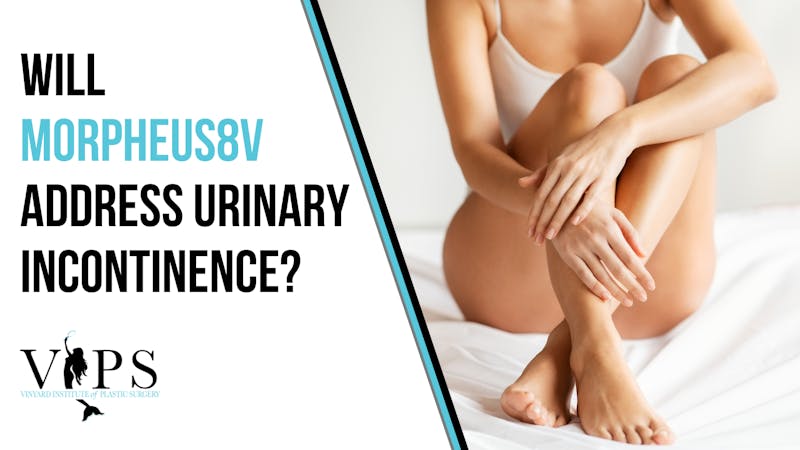
Navigating urinary incontinence can be a daunting and often confidence-knocking journey for many women. This common issue, affecting 50% of women below 65 years in the U.S., can disrupt daily routines and limit social interactions, leaving us searching for effective solutions.
Urinary incontinence is an issue that can be exacerbated by life events such as childbirth, aging, and menopause. Yet, despite its prevalence, women have low rates of treatment and care seeking for urinary incontinence.
This is where Morpheus8V, a groundbreaking technology designed to revolutionize women’s wellness and overall well-being, shines! By offering more than just aesthetic benefits,, Morpheus8V addresses urinary incontinence head-on, providing women with the much-needed hope of regaining control over their lives and embracing their femininity with renewed vitality.
What Causes Urinary Incontinence and Who Is at Risk?
The most common causes of stress urinary incontinence are weakened pelvic floor muscles, hormonal changes, and natural aging. Other factors like a weak anterior vaginal wall and vaginal laxity also cause an overactive bladder.
Women experiencing urinary incontinence may feel embarrassed and experience discomfort during sexual activity. In severe cases, it can lead to chronic vaginal infections or lichen sclerosis, which weakens the vulvar tissues resulting in vaginal atrophy.
Urinary incontinence can affect women of all ages. Still, certain factors may increase the risk of developing the condition, such as undergoing one or more vaginal childbirths, experiencing prolonged labor, or delivering a large baby.
Women at risk for urinary incontinence experience hormonal changes during menopause, aging, chronic constipation, obesity, and certain medical conditions such as diabetes and neurological disorders. In addition, women who smoke, have a history of pelvic surgery, or regularly engage in high-impact activities such as running or jumping may also be at increased risk for urinary incontinence.
How Do I Know If I Have Incontinence?
There are several signs and symptoms to look out for if you suspect you’re dealing with urinary incontinence. The most apparent symptom is the involuntary leakage of urine, which may occur during physical activities like coughing, sneezing, laughing, or exercising.
You may also experience a sudden and intense urge to urinate that is difficult to control, or you may need to urinate frequently throughout the day or night.
However, hope is not lost! Morpheus8V tightens vaginal and vulvar tissue and improves bladder control, blood flow, and collagen production. We can provide a precise treatment plan tailored to your unique needs by scheduling a consultation with Board-Certified Plastic Surgeon William J. Vinyard, MD, FACS, and his expert team!

Is There a Difference Between Stress Urinary Incontinence and Urge Incontinence?
Stress urinary incontinence is characterized by urine leakage when pressure, such as coughing, sneezing, or exercising, is exerted on the bladder. In contrast, urge incontinence involves a sudden, intense urge to urinate, followed by an involuntary loss of urine. Women with urge incontinence may also experience the need to urinate frequently, including throughout the night. While both conditions can be disruptive and impact the quality of life, they have different causes.
There are several other types of urinary incontinence, including:
- Overflow incontinence (frequent or constant dribbling of urine due to incomplete bladder emptying)
- Functional incontinence (physical or mental impairment that prevents timely access to the toilet)
- Mixed incontinence (experiencing a combination of stress incontinence and urge incontinence)
Will Nonsurgical Vaginal Rejuvenation Treatments Fix Urinary Incontinence?
If tedious Kegel exercises don’t have the desired effect, there are alternative solutions that deliver results! While nonsurgical vaginal rejuvenation treatments may not work for everyone, they offer a safe and effective alternative to surgery for many women who suffer from urinary incontinence!
Other factors, such as overactive bladder or stress urinary incontinence, may also play a role in urinary incontinence and should be addressed with nonsurgical treatments.
Morpheus8V and FormaV
Nonsurgical vaginal rejuvenation treatments such as Morpheus8V and FormaV effectively address urinary incontinence in women!
Morpheus8V is a noninvasive procedure that uses radiofrequency energy to stimulate collagen production and tighten the soft tissue in the vaginal canal, thus reducing vaginal laxity and improving urinary incontinence.
FormaV is another nonsurgical option that uses radiofrequency energy to deliver heat to the vaginal tissues, stimulating collagen production and tightening the vaginal walls. This procedure can also improve vaginal dryness, sexual function, and overall vaginal wellness.
Most patients report minimal pain during the procedures, usually taking less than an hour to complete. Recovery is minimal, and patients can return to their daily activities immediately after the treatments, although they should avoid putting anything inside the vagina for 3 days.
Morpheus8V Addresses Urinary Incontinence!
Morpheus8V is a vaginal rejuvenation treatment that has been shown to effectively address urinary incontinence without needing surgery. The procedure uses RF energy to penetrate the soft tissue in the vaginal canal, stimulating collagen and elastin production and tightening the connective tissue.
Collagen production is essential for maintaining the skin’s elasticity, so Morpheus8V’s collagen support provides a tightening action in the vaginal area that can help treat urinary incontinence. In addition, RF energy delivers heat to the soft tissue, which causes collagen contraction and promotes new collagen formation, thereby tightening and rejuvenating the vaginal tissue.
Morpheus8V is considered a more comfortable procedure than other more invasive forms of surgery, and most patients can return to their daily activities immediately after the treatment. During the procedure, a topical anesthetic is used to ensure patient comfort.
Overall, Morpheus8V provides a practical, nonsurgical treatment option for women seeking to treat urinary incontinence and improve their quality of life.
Beyond Incontinence: Other Benefits of Morpheus8V Treatment for Vaginal Wellness
Morpheus8V offers more than just relief from urinary incontinence! The procedure can also improve overall vaginal wellness, addressing vaginal atrophy, vaginal dryness, and vaginal laxity.
The combination of ultra-fine needles and radiofrequency energy works to improve vaginal tissue health, strengthen vaginal muscles, and increase sexual function. Morpheus8V also helps restore women’s natural balance, enhancing women’s wellness!
Take Control of Your Intimate Wellness with Morpheus8V!
As you consider your journey to treat urinary incontinence, Dr. Vinyard and his team of experts wield many options for restoring a stronger pelvic floor! Morpheus8V is an incredible addition to your treatment plan, and Dr. Vinyard and his team of experts are ready to support you in achieving your aesthetic and functional goals. Contact us to schedule a consultation with Dr. Vinyard, or call us at (772) 212-0304 to discover the next steps in your Morpheus8V journey! Our office at 291 NW Peacock Blvd, Suite 103, Port St. Lucie, FL 34986, proudly serves the South Florida area! We also invite you to check out our blog page, Facebook, and Instagram to learn more about the treatment options available at our office!
References:
- https://www.health.harvard.edu/bladder-and-bowel/types-of-urinary-incontinence — Accessed 28 February 2023.
- https://www.mayoclinic.org/diseases-conditions/urinary-incontinence/symptoms-causes/syc-20352808 — Accessed 28 February 2023.
- https://www.mayoclinichealthsystem.org/hometown-health/speaking-of-health/is-urine-incontinence-normal-for-women — Accessed 28 February 2023.
- https://pmc.ncbi.nlm.nih.gov/articles/PMC2944440/ — Accessed 28 February 2023.
- https://www.nhs.uk/conditions/urinary-incontinence/symptoms/ — Accessed 28 February 2023.




